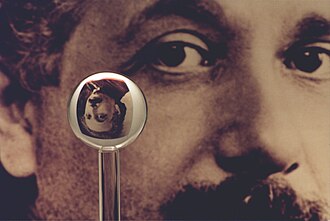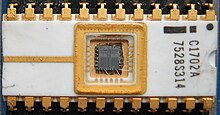Fused quartz

Fused quartz,fused silicaorquartz glassis aglassconsisting of almost puresilica(silicon dioxide, SiO2) inamorphous(non-crystalline) form. This differs from all other commercial glasses, such assoda-lime glass,lead glass,orborosilicate glass,in which other ingredients are added which change the glasses' optical and physical properties, such as lowering the melt temperature, the spectral transmission range, or the mechanical strength. Fused quartz, therefore, has high working and melting temperatures, making it difficult to form and less desirable for most common applications, but is much stronger, more chemically resistant, and exhibits lowerthermal expansion,making it more suitable for many specialized uses such as lighting and scientific applications.
The termsfused quartzandfused silicaare used interchangeably but can refer to different manufacturing techniques, resulting in different trace impurities. However fused quartz, being in theglassy state,has quite different physical properties compared to crystallinequartzdespite being made of the same substance.[2]Due to its physical properties it finds specialty uses insemiconductorfabrication and laboratory equipment, for instance.
Compared to other common glasses, the optical transmission of pure silica extends well into theultravioletandinfraredwavelengths, so is used to makelensesand other optics for these wavelengths. Depending on manufacturing processes, impurities will restrict the optical transmission, resulting in commercial grades of fused quartz optimized for use in the infrared, or in the ultraviolet. The lowcoefficient of thermal expansionof fused quartz makes it a useful material for precision mirror substrates oroptical flats.[3]
Manufacture[edit]
Fused quartz is produced byfusing(melting) high-purity silica sand, which consists ofquartzcrystals. There are four basic types of commercial silica glass:
- Type I is produced by induction melting natural quartz in a vacuum or an inert atmosphere.
- Type II is produced by fusing quartz crystal powder in a high-temperature flame.
- Type III is produced by burningSiCl4in ahydrogen-oxygenflame.
- Type IV is produced by burning SiCl4in a water vapor-free plasma flame.[4]
Quartz contains only silicon and oxygen, although commercial quartz glass often contains impurities. Two dominant impurities arealuminiumandtitanium[5]which affect the optical transmission at ultraviolet wavelengths. If water is present in the manufacturing process,hydroxyl(OH) groups may become embedded which reduces transmission in the infrared.
Fusion[edit]
Melting is effected at approximately 2200 °C (4000 °F) using either an electrically heated furnace (electrically fused) or a gas/oxygen-fuelled furnace (flame-fused).[6]Fused silica can be made from almost anysilicon-rich chemical precursor, usually using a continuous process which involves flameoxidationof volatile silicon compounds to silicon dioxide, and thermal fusion of the resulting dust (although alternative processes are used). This results in a transparent glass with an ultra-high purity and improved optical transmission in the deep ultraviolet. One common method involves addingsilicon tetrachlorideto a hydrogen–oxygen flame.[citation needed]
Product quality[edit]
Fused quartz is normally transparent. The material can, however, become translucent if small air bubbles are allowed to be trapped within. The water content (and therefore infrared transmission) of fused quartz is determined by the manufacturing process. Flame-fused material always has a higher water content due to the combination of the hydrocarbons and oxygen fueling the furnace, forminghydroxyl[OH] groups within the material. An IR grade material typically has an [OH] content below 10 ppm.[7]
Applications[edit]
Many optical applications of fused quartz exploit its wide transparency range, which can extend well into the ultraviolet and into the near-mid infrared. Fused quartz is the key starting material foroptical fiber,used for telecommunications.
Because of its strength and high melting point (compared to ordinaryglass), fused quartz is used as an envelope forhalogen lampsandhigh-intensity discharge lamps,which must operate at a high envelope temperature to achieve their combination of high brightness and long life. Some high-powervacuum tubesused silica envelopes whose good transmission at infrared wavelengths facilitatedradiation coolingof theirincandescent anodes.
Because of its physical strength, fused quartz was used in deep diving vessels such as thebathysphereandbenthoscopeand in the windows of crewed spacecraft, including theSpace ShuttleandInternational Space Station.[8]Fused quartz was used also incomposite armourdevelopment.[9]
In the semiconductor industry, its combination of strength, thermal stability, and UV transparency makes it an excellent substrate forprojection masksforphotolithography.

Its UV transparency also finds use as windows onEPROMs(erasable programmableread only memory), a type ofnon-volatile memorychipwhich is erased by exposure to strong ultraviolet light. EPROMs are recognizable by the transparent fused quartz (although some later models use UV-transparent resin) window which sits on top of the package, through which thesiliconchip is visible, and which transmitsUV lightfor erasing.[10][11]
Due to the thermal stability and composition, it is used in5D optical data storage[12]and in semiconductor fabrication furnaces.[13][14]
Fused quartz has nearly ideal properties for fabricatingfirst surface mirrorssuch as those used intelescopes.The material behaves in a predictable way and allows the optical fabricator to put a very smooth polish onto the surface and produce the desired figure with fewer testing iterations. In some instances, a high-purity UV grade of fused quartz has been used to make several of the individual uncoated lens elements of special-purpose lenses including the Zeiss 105 mm f/4.3 UV Sonnar, a lens formerly made for the Hasselblad camera, and the Nikon UV-Nikkor 105 mm f/4.5 (presently sold as the Nikon PF10545MF-UV) lens. These lenses are used for UV photography, as the quartz glass can be transparent at much shorter wavelengths than lenses made with more commonflintorcrownglass formulas.
Fused quartz can be metallised and etched for use as a substrate for high-precision microwave circuits, the thermal stability making it a good choice for narrowband filters and similar demanding applications. The lowerdielectric constantthan alumina allows higher impedance tracks or thinner substrates.
Refractory material applications[edit]
Fused quartz as an industrial raw material is used to make various refractory shapes such as crucibles, trays, shrouds, and rollers for many high-temperature thermal processes includingsteelmaking,investment casting,and glass manufacture. Refractory shapes made from fused quartz have excellent thermal shock resistance and are chemically inert to most elements and compounds, including virtually all acids, regardless of concentration, excepthydrofluoric acid,which is very reactive even in fairly low concentrations. Translucent fused-quartz tubes are commonly used tosheathe electric elements in room heaters,industrial furnaces, and other similar applications.
Owing to its low mechanical damping at ordinary temperatures, it is used forhigh-Qresonators, in particular, forwine-glass resonatorof hemispherical resonator gyro.[15][16]For the same reason fused quartz is also the material used for modern glass instruments such as theglass harpand theverrophone,and is also used for new builds of the historicalglass harmonica,giving these instruments a greater dynamic range and a clearer sound than with the historically usedlead crystal.
Quartz glassware is occasionally used in chemistry laboratories when standardborosilicate glasscannot withstand high temperatures or when high UV transmission is required. The cost of production is significantly higher, limiting its use; it is usually found as a single basic element, such as a tube in a furnace, or as a flask, the elements in direct exposure to the heat.
Properties of fused quartz[edit]
The extremely low coefficient of thermal expansion, about5.5×10−7/K(20–320 °C), accounts for its remarkable ability to undergo large, rapid temperature changes without cracking (seethermal shock).

Fused quartz is prone tophosphorescenceand "solarisation"(purplish discoloration) under intense UV illumination, as is often seen inflashtubes."UV grade" synthetic fused silica (sold under various tradenames including "HPFS", "Spectrosil", and "Suprasil" ) has a very low metallic impurity content making it transparent deeper into the ultraviolet. An optic with a thickness of 1 cm has a transmittance around 50% at awavelengthof 170 nm, which drops to only a few percent at 160 nm. However, its infrared transmission is limited by strongwater absorptionsat 2.2 μm and 2.7 μm.
"Infrared grade" fused quartz (tradenames "Infrasil", "Vitreosil IR", and others), which is electrically fused, has a greater presence of metallic impurities, limiting its UV transmittance wavelength to around 250 nm, but a much lower water content, leading to excellent infrared transmission up to 3.6 μm wavelength. All grades of transparent fused quartz/fused silica have nearly identical mechanical properties.
Refractive index[edit]
Theoptical dispersionof fused quartz can be approximated by the followingSellmeier equation:[17]
where the wavelengthis measured in micrometers. This equation is valid between 0.21 and 3.71 μm and at 20 °C.[17]Its validity was confirmed for wavelengths up to 6.7 μm.[4]Experimental data for the real (refractive index) and imaginary (absorption index) parts of the complex refractive index of fused quartz reported in the literature over the spectral range from 30 nm to 1000 μm have been reviewed by Kitamuraet al.[4]and areavailable online.
Its quite highAbbe Numberof 67.8 makes it among the lowestdispersionglasses at visible wavelengths, as well as having an exceptionally low refractive index in the visible (nd= 1.4585). Note that fused quartz has a very different and lower refractive index compared to crystallinequartzwhich isbirefringentwith refractive indicesno= 1.5443 andne= 1.5534 at the same wavelength. Although these forms have the same chemical formula, their differing structures result in different optical and other physical properties.
List of physical properties[edit]
- Density:2.203 g/cm3
- Hardness:5.3–6.5 (Mohs scale), 8.8GPa
- Tensile strength:48.3MPa
- Compressive strength:> 1.1 GPa
- Bulk modulus:~37 GPa
- Rigidity modulus:31 GPa
- Young's modulus:71.7 GPa
- Poisson's ratio:0.17
- Lamé elastic constants:λ= 15.87 GPa,μ= 31.26 GPa
- Coefficient of thermal expansion:5.5 × 10−7/K (average 20–320 °C)
- Thermal conductivity:1.3 W/(m·K)
- Specific heat capacity:45.3 J/(mol·K)
- Softening point:≈ 1665 °C
- Annealing point:≈ 1140 °C
- Strain point:1070 °C
- Electrical resistivity:> 1018Ω·m
- Dielectric constant:3.75 at 20 °C 1 MHz
- Dielectric loss factor:less than 0.0004 at 20 °C 1 MHz typically 6 × 10−5at 10 GHz[18]
- Dielectric strength:250–400 kV/cm at 20 °C[19]
- Magnetic susceptibility:−11.28 × 10−6(SI, 22 °C)[20]
- Hamaker constant:A= 6.5 × 10−20J.
- Surface tension:0.300 N/m at 1800–2400 °C[21]
- Index of refraction:nd= 1.4585 (at 587.6 nm)
- Change of refractive index with temperature: 1.28 × 10−5/K (20–30 °C)[17]
- Transmission range:Cutoff – 160 to 5000 nm, with a deep absorption band at 2730 nm. Besttransmittance– 180 to 2700 nm.[22]
- Stress-optic coefficients:p11= 0.113,p12= 0.252.
- Abbe number:Vd = 67.82[23]
See also[edit]
References[edit]
- ^ Hardwood, W. (20 April 2004)."Spacecraft launched to test Albert Einstein's theories".Spaceflight Now.Retrieved14 May2009.
- ^"Quartz vs. Fused Silica: What's the Difference?".Swift Glass.2015-09-08.Retrieved2017-08-18.
- ^De Jong, Bernard H. W. S.; Beerkens, Ruud G. C.; Van Nijnatten, Peter A. (2000). "Glass".Ullmann's Encyclopedia of Industrial Chemistry.doi:10.1002/14356007.a12_365.ISBN3-527-30673-0.
- ^abcKitamura, Rei; Pilon, Laurent; Jonasz, Miroslaw (2007-11-19)."Optical Constants of Silica Glass From Extreme Ultraviolet to Far Infrared at Near Room Temperatures"(PDF).Applied Optics.46(33): 8118–8133.Bibcode:2007ApOpt..46.8118K.doi:10.1364/AO.46.008118.PMID18026551.S2CID17169097.Retrieved2014-07-12.
- ^Chemical purity of fused quartz / fused silica,www.heraeus-quarzglas.com
- ^Varshneya, Arun K. (2019).Fundamentals of inorganic glasses.John C. Mauro. Amsterdam.ISBN978-0-12-816226-2.OCLC1101101049.
{{cite book}}:CS1 maint: location missing publisher (link) - ^"Fused quartz - Acemap".ddescholar.acemap.info.Retrieved2023-07-04.
- ^Salem, Jonathan (2012)."Transparent Armor Ceramics as Spacecraft Windows".Journal of theAmerican Ceramic Society.
- ^Evaluation of Siliceous Cored Armor for the XM60 TankArchivedJune 5, 2011, at theWayback Machine
- ^"Intel 1702A 2K (256 x 8) UV Erasable PROM"(PDF).
- ^"CPU History - EPROMs".www.cpushack.com.Retrieved2021-05-12.
- ^Kazansky, P.; et al. (11 March 2016)."Eternal 5D data storage via ultrafast-laser writing in glass".SPIE Newsroom.
- ^"Fused Quartz and Silica Plates for Semiconductor Applications".Heraeus Holding GmbH.Retrieved2022-08-07.
- ^"Quartz Properties".finkenbeiner.com.Retrieved2022-08-07.
- ^An Overview of MEMS Inertial Sensing Technology,February 1, 2003
- ^Penn, Steven D.; Harry, Gregory M.; Gretarsson, Andri M.; Kittelberger, Scott E.;Saulson, Peter R.;Schiller, John J.; Smith, Joshua R.; Swords, Sol O. (2001). "High quality factor measured in fused silica".Review of Scientific Instruments.72(9): 3670–3673.arXiv:gr-qc/0009035.Bibcode:2001RScI...72.3670P.doi:10.1063/1.1394183.S2CID11630697.
- ^abcMalitson, I. H. (October 1965)."Interspecimen Comparison of the Refractive Index of Fused Silica"(PDF).Journal of the Optical Society of America.55(10): 1205–1209.Bibcode:1965JOSA...55.1205M.doi:10.1364/JOSA.55.001205.Retrieved2014-07-12.
- ^"Keysight Technologies GENESYS Concepts"(PDF).Keysight Technologies.
- ^"Fused Silica".OpticsLand.Archived fromthe originalon 2013-06-02.Retrieved2016-02-27.
- ^Wapler, M. C.; Leupold, J.; Dragonu, I.; von Elverfeldt, D.; Zaitsev, M.; Wallrabe, U. (2014). "Magnetic properties of materials for MR engineering, micro-MR and beyond".JMR.242:233–242.arXiv:1403.4760.Bibcode:2014JMagR.242..233W.doi:10.1016/j.jmr.2014.02.005.PMID24705364.S2CID11545416.
- ^Surface tension and viscosity measurement of optical glasses using a scanning CO2laser
- ^Optical Engineering Scienceby Stephen Rolt - Wiley Publishing 2020 Page 211-213
- ^"Refractive Index of Fused Silica (Fused Quartz)".Refractive Index.Retrieved2017-08-18.
External links[edit]
- "Frozen Eye to Bring New Worlds into View"Popular Mechanics,June 1931General Electrics, West Lynn Massachusetts Labs work on large fuzed quartz blocks


